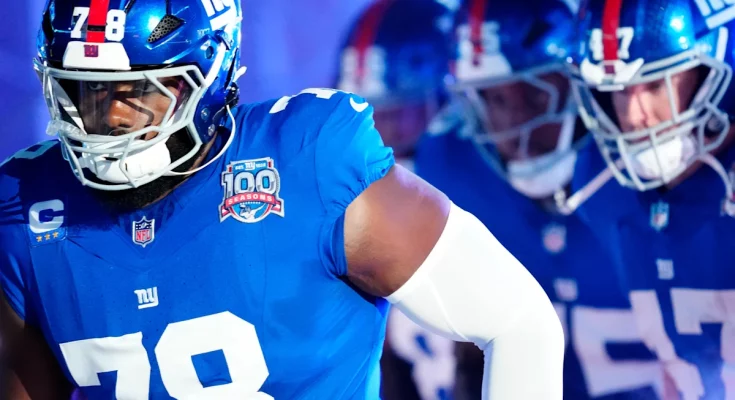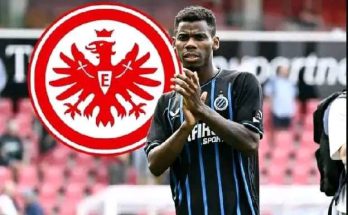When you think of NFL jersey numbers, some are iconic by virtue of the legends who wore them. For the New York Giants, a franchise rich in tradition, grit, and greatness, No. 34 doesn’t immediately scream superstardom like Lawrence Taylor’s No. 56 or Michael Strahan’s No. 92. But the deeper you dig into the team’s history, the more you come to appreciate the understated brilliance and toughness of the men who wore that number. No. 34 has quietly been worn by a few notable players over the years, but one name towers above the rest—Rodney Hampton. His tenure with the Giants not only made him the best to ever wear No. 34 for Big Blue, but also solidified his legacy as one of the more underappreciated running backs of his era.
Rodney Hampton was drafted in the first round of the 1990 NFL Draft, 24th overall out of the University of Georgia, a program that’s known for producing powerhouse running backs. At Georgia, Hampton shared carries in a backfield loaded with talent, but his blend of speed, vision, and power made him an enticing prospect for the Giants, who were looking to bolster their rushing attack and find a long-term answer at the running back position. At that time, the Giants were on the cusp of something special under head coach Bill Parcells, with a suffocating defense, a gritty offensive line, and a locker room culture built around discipline and physicality. Hampton’s arrival provided the offense with a new gear—a dependable, workhorse back who could grind out tough yards and break big plays when given the chance.
His rookie season didn’t start off the way he wanted. He fractured his fibula midway through the year and missed the Giants’ march to a Super Bowl XXV victory. Still, he got a ring. But it was in the seasons that followed that Hampton truly made his mark. From 1991 to 1995, he rattled off five consecutive 1,000-yard seasons, making him the first running back in Giants history to accomplish that feat. In those years, he was a beacon of consistency in an offense that was often in flux. Whether the team was transitioning from Jeff Hostetler to Dave Brown at quarterback or changing offensive coordinators, Hampton was the one constant. He was the guy who could carry the ball 25 times a game, absorb the punishment, and keep the chains moving.
What set Hampton apart wasn’t just the raw numbers—though they were impressive. It was how he got them. He wasn’t a flashy back, not in the Barry Sanders mold where every run felt like a highlight reel. Hampton was more like Emmitt Smith in that sense—disciplined, powerful, and smart. He’d follow his blockers, find the crease, and punish defenders who dared to meet him head-on. He ran behind an offensive line that wasn’t always elite, but he made the most of every opportunity. Even in games where he was bottled up early, he never stopped pounding away. By the fourth quarter, those three-yard runs would turn into eight-yard gains. He wore defenses down, play after play, drive after drive.
One of Hampton’s most memorable seasons came in 1992 when he rushed for a career-high 1,141 yards and scored six touchdowns. That year, he was named to the Pro Bowl, a recognition of his importance not just to the Giants, but to the league as a whole. He wasn’t a media darling or a household name outside of New York, but among those who watched him closely—coaches, teammates, and opposing defenders—there was a deep respect for the way he played the game. Hampton never complained, never demanded more touches, and never let the spotlight distract him from the grind. He showed up, did his job, and led by example.
Injuries started to take their toll by the mid-90s. In 1996, the Giants drafted Tyrone Wheatley, and by 1997, Hampton’s role had diminished significantly. Still, he left the game with 6,897 rushing yards, which at the time of his retirement was the most in franchise history. Though Tiki Barber would later surpass that mark, Hampton set the bar and laid the foundation for what a franchise running back could look like in the modern era for the Giants.
When evaluating the significance of jersey No. 34 in Giants lore, Hampton is the name that defines it. Others have worn the number, some with promise, some with fleeting success, but none with the sustained impact or legacy that Hampton left behind. In fact, when most fans see the number 34 in Giants blue, their minds immediately go to Rodney powering through a linebacker, dragging tacklers for extra yards, or falling forward for a crucial first down late in a game. His style of play embodied the ethos of New York football—tough, resilient, and reliable.
There’s also something poetic about the way Hampton’s career unfolded. He wasn’t part of the Giants’ golden years in the 1980s that featured two Super Bowl appearances under Bill Parcells. He didn’t get to fully enjoy the Giants’ 1990 title season because of injury. Yet he became the bridge between eras. He carried the load during some lean years and helped lay the groundwork for future success. His presence in the backfield gave the Giants an identity at a time when they were desperately trying to find one post-Parcells.
Beyond the stats and accolades, Hampton’s relationship with fans was special. He was one of those players that fans rooted for not just because he was good, but because he carried himself the right way. In a city that often eats its stars alive for underperformance or off-field distractions, Hampton thrived by being humble, hardworking, and dependable. He signed autographs, stayed after practices, and never got caught up in the drama that often surrounds high-profile athletes in big markets. He was the kind of player that parents pointed to and told their kids, “That’s how you do it.”
It’s also worth mentioning that the running back position has always been central to Giants history. From Frank Gifford to Joe Morris to Tiki Barber and even to more recent stars like Saquon Barkley, the team has always leaned on its backs to define its offense. But in terms of toughness and week-to-week durability, few measured up to what Hampton brought to the field. He wasn’t just a player; he was a tone-setter. You knew what kind of game it would be when Hampton was getting the ball. The Giants were going to hit you in the mouth, dominate time of possession, and force opponents to play their style.
Though Rodney Hampton never received Hall of Fame consideration in the same breath as some of his contemporaries, his impact in New York is undeniable. He retired as the franchise’s all-time leading rusher and remained a fan favorite long after his playing days were over. For Giants fans of a certain generation, Hampton is remembered with the same reverence as more decorated stars. He represented a team-first mentality, an old-school work ethic, and a quiet leadership that is increasingly rare in today’s game.
Other players have worn No. 34 for the Giants, but few left a mark. It’s been handed down over the years to backups, special teamers, and players hoping to find their place in the NFL. But the number remains synonymous with Hampton. There’s a sense of reverence attached to it, a quiet recognition that the last guy who truly wore it well was someone special. It’s not just about performance, but about legacy—what you meant to the team, to the fans, and to the city.
In today’s NFL, jersey numbers are more fluid. Running backs wear numbers in the teens. Wide receivers wear single digits. But back when Rodney Hampton was lining up in the I-formation, the number on your jersey still meant something. No. 34 wasn’t just a number—it was a badge of honor. It represented the beating heart of the offense, the guy who took the hits so others could shine. And Hampton wore it with pride.
The NFL has seen countless great backs. Some had longer careers, more Pro Bowls, more highlight reels. But few did more for their franchise, in harder conditions, with less help, than Rodney Hampton did for the New York Giants. That’s why when the discussion comes up—Who wore No. 34 best for the Giants?—there’s only one answer that really makes sense. Rodney Hampton. Tough. Relentless. Underappreciated. But always, undeniably great.



